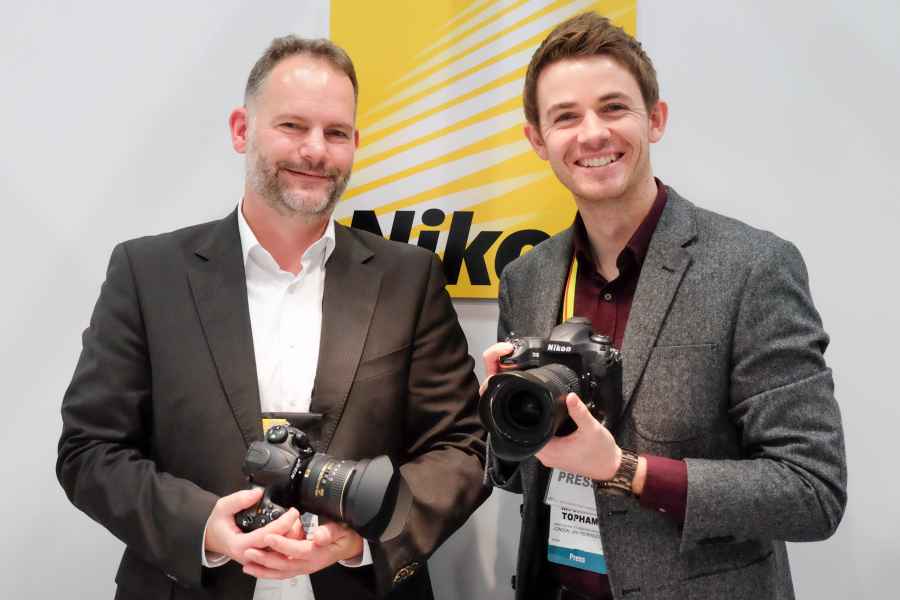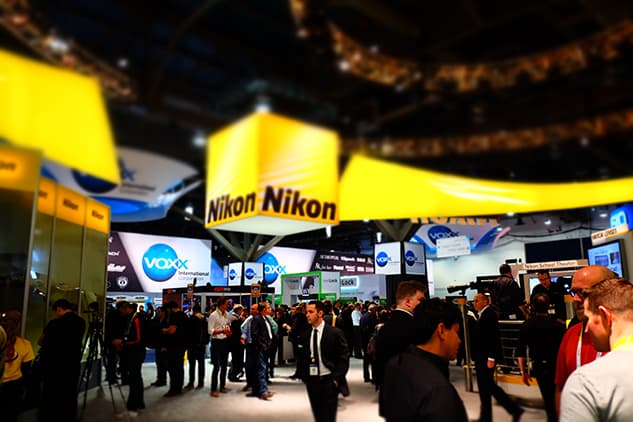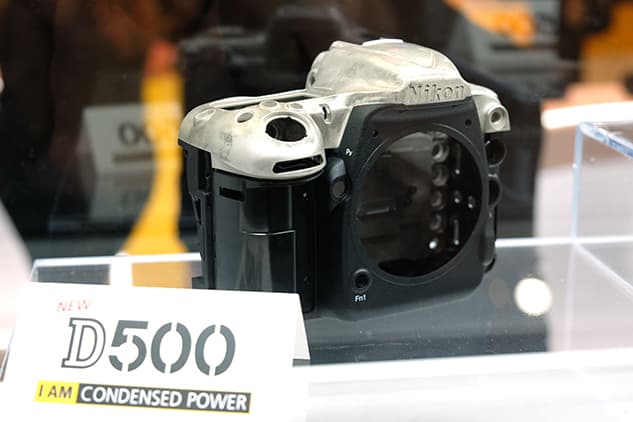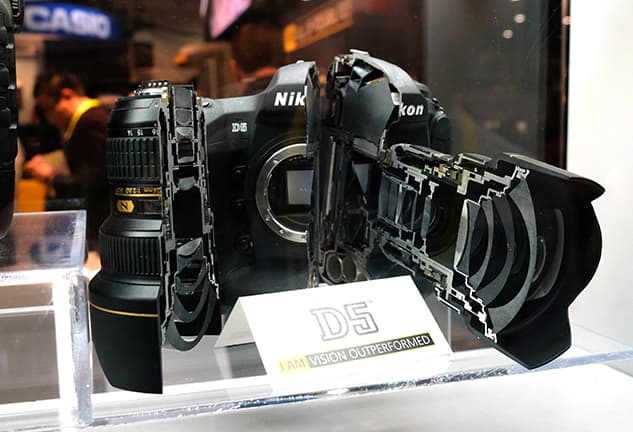During our recent visit to CES 2016, Amateur Photographer had an opportunity to interview Dirk Jesper, Product Manager for Professional Products and Product Planning at Nikon Europe. During our interview we asked a series of questions to find out more about the Nikon D500 and Nikon D5. As well as questions about Nikon’s future plans, Dirk commented on Nikon’s strategy in today’s challenging imaging market.
https://link.brightcove.com/services/player/?bctid=4709860476001
Interview conducted on the 6th January 2016 (10:00am) at CES 2016
AP: Last year was an extremely quiet year from Nikon with only a couple of new DSLR announcements, those being the D5500 and D7200. Can you explain to us why 2015 was a quiet year?
DJ: I can assure you that 2015 wasn’t a quiet year for us because as you can see from yesterday’s announcement we were quite busy in preparing new products. If you want to start with new lineups and new technology it takes a lot of time to bring something to the market – the D500 and D5 are proof of that.
AP: A few Nikon users on our forums imply one reason for the shortage of releases last year was because Nikon has reached a state of perfection. What would you say to these Nikon photographers?
DJ: That’s a very nice thing of them to say, but at Nikon we always endeavour to be better. The state of perfection is never there because the industry is always changing, demands of customers are always changing and one of our jobs is actually to react to that and have products ready that the market needs. Our job is not only to follow but lead that change as well.
AP: With the Nikon D5 and D500 arriving early in the year and of course Photokina to look forward to later in the year, is it fair to say that we’ll see a lot more of Nikon this year?
DJ: It’s fair to say that there’s a long way to go this year and we’re still in the first month. I can’t say anything about future products as you know, but yes I can confirm that the year will be busy.
AP: Can Nikon be clear about who it expects to use the D500, especially given it has quite a high price tag? (The Nikon D500 will cost £1729.99 body only or £2479.99 with 16-80mm kit lens).
DJ: The concept of the D500 from the beginning was to have a very compact, agile and professional system. It’s our DX-format flagship and it shares so much technology with the D5. For example, it has the very same autofocus system and the target audience comes automatically – we’re looking at high-grade enthusiasts and professionals who let’s say need to walk with limited equipment and require something that’s compact, yet need the performance of a professional camera. It’s ideal for wildlife photographers who want to take advantage of the crop factor.
AP: The Nikon D500 has the same relationship to the Nikon D5 as the Nikon D300 did to the Nikon D3. But notably there was no Nikon D400. Was neglecting this part of the market a mistake?
DJ: That’s true, it has been a while since we have launched a camera in that segment (DX-format), but to be honest this D500 is actually better and on an even higher level than the D300S was, not just because it’s newer technology, but also the concept – the body is more sturdy and we share a greater part of the technology with full-frame with this model than we did say for example with the Nikon D3 and D300/D300S. We’ve been watching the market very closely and we’ve been developing our technology so we can have this leap in quality and performance.
AP: Why have we waited so long for a successor to the D300S? Did the tsunami disaster back in 2011 prevail Nikon launching a D400?
DJ: No, absolutely not. The tsunami was a terrible catastrophe. It had impact of course on our production, but the development of cameras happens somewhere else. It hit our production sites in the Sendai district and as you may remember we had some delivery problems in certain segments after that period, but we have fully recovered and it never had a negative impact on our development.
AP: The D500 has a tilting screen. Why this, rather than fully articulated, which is better suited for stills photographers?
DJ: Well, the idea was to have the best compromise between usability but also sturdiness. If you have a fully articulated screen it’s also more vulnerable and as pointed out before, this is a professional-grade camera, which we expect will be used in very tough conditions. You have to be able to rely on the equipment and you don’t want the screen to get easily damaged under any circumstances. It’s the perfect balance between usability and sturdiness.
AP: Why has CF been omitted from the Nikon D500 in favour of XQD?
DJ: Well that’s a simple question because it’s all about performance. The CF card which were part of the professional photography world for so long have actually reached the end of what’s possible. You won’t see CF cards becoming faster, whereas XQD is a format that is future proof. The current generations of XQD cards available are several times faster than CF. Looking into the frame rates, the D500 can shoot at 10fps whereas the D5 can shoot up to 14fps. This generates a lot of data which needs to get onto the card and 4K video comes with huge file sizes. You need to handle that and you don’t want to be slowed down because your card is lagging behind when it comes to transferring data. It’s also important to get the data from the card onto your computer and into your workflow system quickly. XQD can be up to five times faster (than CF) depending on the card, so that’s the main reason.
AP : What advantages do you envisage photographers might gain from Snapbridge compared to Wi-Fi? Does it for example benefit working pro sports photographers?
DJ: The D500 is the first camera we’ve introduced with SnapBridge. One of the major benefits is that it’s always on and you’re always live. You connect the camera to your smart device only once and you never have to do it again. It involves an automatic handshake that’s not possible with Wi-fi. With Wi-fi you have to set it up every time manually. Another disadvantage of Wi-fi, though it is much faster than Bluetooth, is the energy consumption is very high. Bluetooth uses 1-3% of the energy that is used for Wi-fi and that is a huge benefit because the drain of battery is close to zero. You can still use Wi-fi if you want to or if you have large files you need to transfer, but if you always want to be live and want instant sharing we use Bluetooth.
AP: There are some who are under the impression that the number of APS-C DSLRs are declining. What’s Nikon’s view on the up-take of APS-C DSLRs in coming years?
DJ: We see it just as we did in the past and our opinion hasn’t changed. Both full-frame systems and DX sensor size systems live side-by-side. Both of them have there reasons to be there. The benefit you have from a DX-format camera is that it’s very compact. If we look at the D3300, D5300 or D5500 they’re really compact and lightweight. This (the Nikon D500) is slightly heavier and bulkier but this is in part due to the fact it’s built to be like a tank. It’s a matter of choice. You can buy into full frame systems, but they will be bigger and more bulky, on the other hand they will give you advantages in ISO performance.
AP: People want to know more about the maximum recording time on the D5 when shooting 4K. Can you tell us why it’s limited to three minutes and whether it has anything to do with the weather sealing of the camera?
DJ: No, it has nothing to do with the weather sealing of the camera. It’s a matter of processing and the heat which is generated during processing. We work with a generic crop on the sensor for the 4K, however the primary concept and idea of this camera is not about video. The D500 goes the full half an hour (29mins and 59seconds) but the focus was different here. Based upon the feedback of the users of this camera (the Nikon D5), which are mostly journalists and sports photographers, they tend to record short snippets rather than lengthy live coverage.
AP: Technically, how are such high sensitivities achieved? What kind of modifications to the sensor have been made to enable them?
DJ: That is confidential. Our engineers have put a lot of effort into the design of the sensors and they’re pure Nikon design. As we do for all our flagship cameras, we have built upon the experience we have gained over the years since we introduced our flagship cameras and have improved ever since. We have increased the pixel count of this camera (Nikon D5) another 25% over its predicessor the D4S, nevertheless we manage to gain better dynamic range and better ISO. We even have more energy effiecient management inside this camera and it uses the exact same battery as used with the Nikon D4S. You can go for much longer than you could with the Nikon D4S.
AP: What does Nikon envisage ultra-high ISOs might be used for? Is there a strong user demand?
DJ: The high ISO that extends beyond three million (on the Nikon D5) is not the main focus. The main focus is between ISO 6400-12800 and up to ISO 51,200 and you’ll get much better results there. This is the field where most sports and journalists have to work in and they often have to work in poor light conditions indoors and at events. You want to have images that are as clean as possible so that’s the focus. The fact we can go up to three-million ISO is a side effect. It might be interesting for let’s say military, police or surveillance use, but of course you can’t expect the same clean image quality.
AP: The focus system is described as ‘Next generation intelligent AF’. What does this mean for the user?
DJ: Well for the user it means that you’ve got a new focus system that is much faster, much more capable and leaves almost no gaps on the frame. We have tripled the amount of focus fields. We have actually also now have 99 cross type autofocus fields on this camera and we have also distributed them, not only in the centre, but also on the edges of the frame, which is extremely helpful if you are shooting a lot of portraits, for example during red carpet photography. So the sensitivity of the autofocus system has been increased up to -4EV in the centre, which helps in very poor light conditions to gain focus. Yesterday we’ve been on trip visiting a gold mine with very poor light, and it is amazing how the autofocus could perform. You just hold it in to the dark and focusing is amazing.
AP: How important is it that the D5 is ready for the Olympics this year?
DJ: Well it is. It is planned to come to the market in March, so it surely will be there before the Olympic games and also Euro 2016 coming up. I think the first feedback that we have gained from photograohers has been pretty awesome and we look forward to the summer.
AP: There are a few areas of the market Nikon is yet to exploit – a large sensor mirrorless camera and a large sensor pocket compact being prime examples. Rival manufacturers are producing these types of cameras, which asks the question; when will Nikon do the same?
DJ: We are always considering and looking in to what the market needs, and trust me we will follow that very closely. Of course I can say nothing about future product launches but if we think the time is there to launch something in that field we will do it.
AP: Where does Nikon see its future in the CSC market? Is it a priority?
DJ: Our prioirty is a very strong word because you cant have one prioirty any more, that is no longer possible. The imaging market is diversifying more and more. I mean, yesterday we launched the KeyMission 360, which also reflects that – its a brand new concept. So you have to find the balance because the needs of our customers have become more diversified as well. So there is the compact side on one hand then there is performance on the other. One of the points why mobile phones are so popular is that they are convenient. They are easy to take pictures, easy to share. Everyone acknowledges that the image quality isn’t that great, but what we now try and close the gap between instagram and sharing with SnapBridge.
AP: Nikon has persisted with the Nikon 1-system for a long time. Will Nikon actively look to develop the Nikon 1-system in the future?
DJ: We keep on with the Nikon 1 system because the whole concept behind the Nikon 1 system was to have a high performance, easy to use camera. Actually the marekt responded very well to that. Our intention was never to reach in to the DSLR and say the Nikon 1 should never be a replacement for a DSLR.
AP: Before Christmas, there was much press speculation that Nikon had bought Samsung’s NX camera business. Are you able to give us a reaction to the many media reports about this?
DJ: As you learn from the media and also from official feedback that was a hoax. There was never anybody really talking about it.
AP: What’s Nikon’s strategy going forward into 2016 and 2017.
DJ: Our strategy is very clear and simple. Bring out the best imaging products that you can imagine, for the future. Nikon is also spreading out to other fields of business but that is more medical and industry related business, as you may have seen from my messaging earlier this year and last year. But for imaging, we are a leader in the imaging market and want to stay there.
Nikon D4S vs Nikon D5 – 16 Key Differences
To find out more about the new Nikon D5 and how it stacks up against its predecessor don’t miss our Nikon D4S vs Nikon D5 comparison that looks at all the key differences between the two.











